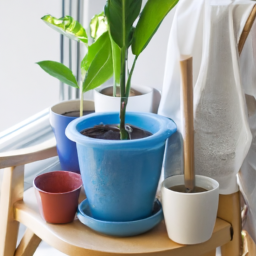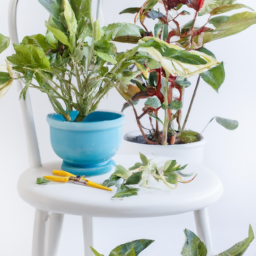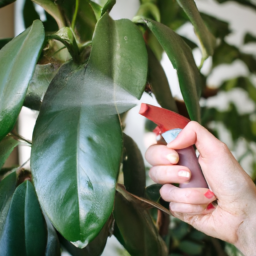
Are you looking to improve your indoor plant care skills? If so, you’ve come to the right place! Taking care of indoor plants can be a rewarding and fulfilling hobby, but it can also be a bit overwhelming if you’re not sure where to start. In this blog post, we’ll cover everything you need to know about caring for indoor plants, from choosing the right plants for your space to providing them with the proper care and maintenance they need to thrive. So grab your watering can and let’s dive into the wonderful world of caring for indoor plants!
The Importance of Indoor Plants
Indoor plants are not just for decoration; they also have numerous benefits for our health and well-being. Studies have shown that having plants in your home or office can improve air quality, reduce stress levels, boost mood, and even increase productivity. In this article, we will explore the various ways in which indoor plants can positively impact our lives.
Improving Air Quality
One of the most well-known benefits of indoor plants is their ability to purify the air. Plants absorb carbon dioxide and release oxygen through the process of photosynthesis, which helps to freshen up the air in enclosed spaces. In addition, plants can also remove toxins and pollutants from the air, such as formaldehyde and benzene, which are commonly found in indoor environments. By having plants in your home or office, you can breathe cleaner and healthier air.
Some of the best plants for improving air quality include spider plants, peace lilies, snake plants, and pothos. These plants are known for their ability to filter out harmful substances and improve overall air circulation. By incorporating these plants into your indoor space, you can create a healthier environment for yourself and your loved ones.
It is important to note that different plants have different air-purifying capabilities, so it is recommended to have a variety of plants in your indoor space to maximize the benefits. Regularly watering and caring for your plants will also help them thrive and continue to improve air quality.
Reducing Stress Levels
In today’s fast-paced world, stress has become a common problem for many people. Fortunately, indoor plants can help to reduce stress levels and promote relaxation. Studies have shown that simply being around plants can have a calming effect on the mind and body, leading to lower levels of anxiety and tension.
The presence of plants in indoor spaces has been linked to improved mood and mental well-being. The color green, which is abundant in plants, is known to have a soothing and calming effect on the eyes and brain. By surrounding yourself with greenery, you can create a peaceful and tranquil environment that promotes relaxation and stress relief.
Incorporating plants into your home or office decor can help to create a sense of connection with nature, even in urban environments. Taking care of plants and watching them grow can be a therapeutic and rewarding experience that can help you unwind and de-stress after a long day.
Boosting Mood and Productivity
Indoor plants have the power to uplift your mood and increase productivity. The presence of plants in indoor spaces has been shown to improve concentration, memory, and creativity. By creating a green and vibrant environment, you can enhance your mood and motivation, leading to better performance and efficiency.
Plants can also help to reduce fatigue and increase energy levels. The natural beauty and calming presence of plants can inspire feelings of happiness and positivity, which can have a profound impact on your overall well-being. By incorporating plants into your workspace, you can create a more inviting and inspiring atmosphere that encourages productivity and success.
Whether you are working from home or in an office setting, adding plants to your indoor space can make a significant difference in your mood and productivity. Choose plants that are easy to care for and suit your personal style to create a harmonious and uplifting environment that supports your well-being.

Essential Tips for Proper Indoor Plant Care
Choosing the Right Plants
When it comes to caring for indoor plants, the first step is choosing the right plants for your space. Consider factors such as the amount of light available, the humidity levels, and the temperature of the room. Some plants thrive in low light conditions, while others require bright, indirect sunlight. Make sure to research each plant’s specific needs before bringing them home.
Additionally, consider the size of the plant and how much space it will need to grow. Some plants, such as fiddle leaf figs, can grow quite large and may require regular pruning to keep them in check. If you have limited space, opt for smaller plants like succulents or air plants that can thrive in smaller pots.
Lastly, consider your own lifestyle and how much time you can dedicate to caring for your plants. Some plants require more frequent watering and maintenance, while others are more low-maintenance. Choose plants that fit your schedule and level of expertise to ensure their long-term health.
Proper Watering Techniques
One of the most important aspects of indoor plant care is proper watering. Overwatering is a common mistake that can lead to root rot and other issues, so it’s important to water your plants only when they need it. Check the soil moisture by sticking your finger into the soil – if it feels dry to the touch, it’s time to water. Be sure to water thoroughly, allowing the water to drain out of the bottom of the pot to prevent waterlogged soil.
On the other hand, underwatering can also be detrimental to your plants. Some plants, like succulents, prefer to dry out between waterings, while others, like ferns, prefer consistently moist soil. Research the specific watering needs of each plant in your collection to ensure they thrive.
Consider using a moisture meter to accurately gauge the moisture levels in the soil. This can help prevent overwatering and ensure your plants are getting the right amount of water they need to thrive.
Light and Temperature Requirements
Light and temperature are crucial factors in the health of your indoor plants. Most plants require bright, indirect sunlight to thrive, so be sure to place them near a window where they can receive adequate light. If your space lacks natural light, consider using grow lights to supplement their light requirements.
Additionally, be mindful of the temperature in your home. Most indoor plants prefer temperatures between 65-75°F during the day and slightly cooler temperatures at night. Avoid placing plants near drafty windows or heating vents, as extreme temperature fluctuations can stress your plants.
Monitor your plants regularly for signs of light or temperature stress, such as yellowing leaves or wilting. Adjust their placement accordingly to ensure they are receiving the right amount of light and are in a temperature-controlled environment.

Common Mistakes to Avoid When Caring for Indoor Plants
Overwatering
When it comes to caring for indoor plants, one of the most common mistakes that people make is overwatering. It’s easy to think that plants need a lot of water to thrive, but in reality, too much water can lead to root rot and other issues. It’s important to let the soil dry out between waterings and to make sure that your plant is in a pot with proper drainage.
Another common mistake related to overwatering is not paying attention to the specific water needs of each plant. Some plants, like succulents, prefer to dry out completely between waterings, while others, like ferns, like to stay consistently moist. It’s important to do your research and understand the specific needs of each plant in your care.
Finally, make sure to use room temperature water when watering your plants. Cold water can shock the roots and lead to stress for your plant.
Ignoring Light Requirements
Another common mistake that people make when caring for indoor plants is ignoring the light requirements of their plants. Different plants have different light needs, and it’s important to place your plants in a spot where they will get the right amount of light. Some plants, like succulents, thrive in bright, direct sunlight, while others, like ferns, prefer lower light conditions.
If you notice that your plant is becoming leggy or not growing as well as it should, it may be a sign that it’s not getting enough light. On the other hand, if your plant’s leaves are turning yellow or brown, it may be getting too much direct sunlight.
It’s important to regularly assess the light conditions in your home and move your plants around as needed to ensure that they are getting the right amount of light.
Not Monitoring Humidity Levels
Indoor plants can be sensitive to changes in humidity levels, and not monitoring humidity levels is another common mistake that people make when caring for their plants. Some plants, like tropical plants, prefer higher humidity levels, while others, like succulents, prefer lower humidity levels.
If you notice that your plant’s leaves are turning brown or crispy, it may be a sign that the humidity levels in your home are too low. You can increase humidity levels by misting your plants regularly, placing a humidifier near your plants, or grouping your plants together to create a microclimate of higher humidity.
On the other hand, if you notice that your plant’s leaves are turning yellow or dropping off, it may be a sign that the humidity levels in your home are too high. In this case, you can decrease humidity levels by ensuring proper air circulation around your plants and avoiding overwatering.
Overall, it’s important to regularly monitor and adjust humidity levels to ensure that your indoor plants are thriving.
By avoiding these common mistakes and following the tips outlined above, you can ensure that your indoor plants are healthy and thriving. Remember to pay attention to the specific needs of each plant, including water, light, and humidity requirements, and to regularly assess and adjust your care routine as needed. With a little bit of knowledge and care, you can enjoy beautiful and thriving indoor plants in your home.
Summary Snapshot
Indoor plants are a great way to bring a touch of nature into your home, but they do require some care to keep them healthy and thriving. One of the most important aspects of caring for indoor plants is ensuring they have the right amount of light. Different plants have different light requirements, so it’s important to place them in a spot where they will get the amount of light they need to thrive.
In addition to light, indoor plants also need to be watered regularly. Overwatering can be just as harmful as underwatering, so it’s important to find the right balance for each plant. It’s also important to keep an eye out for pests and diseases, as these can quickly spread and harm your plants. By taking the time to care for your indoor plants properly, you can enjoy their beauty and benefits for years to come.
Here are this week’s Top Questions and Answers
Q1. How often should I water my indoor plants?
A1. It’s important to water your indoor plants only when the top inch of soil feels dry to the touch. Overwatering can lead to root rot, so be sure to check the soil moisture before watering.
Q2. What is the best way to provide light for indoor plants?
A2. Indoor plants typically need bright, indirect light to thrive. Place them near a window where they can receive plenty of sunlight, but be sure to avoid direct sunlight, which can scorch the leaves.
Q3. How can I prevent pests from infesting my indoor plants?
A3. To prevent pests like spider mites or aphids, regularly inspect your plants for any signs of infestation. You can also wipe down the leaves with a damp cloth or use insecticidal soap to keep pests at bay.
Q4. What is the best way to fertilize indoor plants?
A4. Indoor plants benefit from a balanced fertilizer that is diluted to half strength. Fertilize your plants during the growing season (spring and summer) about once a month to provide them with the nutrients they need to thrive.
Q5. How can I promote healthy growth in my indoor plants?
A5. To promote healthy growth, make sure your indoor plants are in the right-sized pots with good drainage, provide them with proper light and water, and regularly dust off their leaves to allow for better photosynthesis. Additionally, rotate your plants occasionally to ensure even growth on all sides.

James Wong is a renowned ethnobotanist, plant scientist, and local television presenter. With a passion for demystifying plant science, he is known for translating complex botanical concepts into practical advice for everyday plant enthusiasts. James’s expertise spans from traditional gardening to cutting-edge plant technologies, making his insights accessible and informative.


